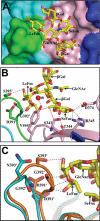Structural analysis of histo-blood group antigen binding specificity in a norovirus GII.4 epidemic variant: implications for epochal evolution
- PMID: 21715503
- PMCID: PMC3165782
- DOI: 10.1128/JVI.00848-11
Structural analysis of histo-blood group antigen binding specificity in a norovirus GII.4 epidemic variant: implications for epochal evolution
Abstract
Susceptibility to norovirus (NoV), a major pathogen of epidemic gastroenteritis, is associated with histo-blood group antigens (HBGAs), which are also cell attachment factors for this virus. GII.4 NoV strains are predominantly associated with worldwide NoV epidemics with a periodic emergence of new variants. The sequence variations in the surface-exposed P domain of the capsid protein resulting in differential HBGA binding patterns and antigenicity are suggested to drive GII.4 epochal evolution. To understand how temporal sequence variations affect the P domain structure and contribute to epochal evolution, we determined the P domain structure of a 2004 variant with ABH and secretor Lewis HBGAs and compared it with the previously determined structure of a 1996 variant. We show that temporal sequence variations do not affect the binding of monofucosyl ABH HBGAs but that they can modulate the binding strength of difucosyl Lewis HBGAs and thus could contribute to epochal evolution by the potentiated targeting of new variants to Lewis-positive, secretor-positive individuals. The temporal variations also result in significant differences in the electrostatic landscapes, likely reflecting antigenic variations. The proximity of some of these changes to the HBGA binding sites suggests the possibility of a coordinated interplay between antigenicity and HBGA binding in epochal evolution. From the observation that the regions involved in the formation of the HBGA binding sites can be conformationally flexible, we suggest a plausible mechanism for how norovirus disassociates from salivary mucin-linked HBGA before reassociating with HBGAs linked to intestinal epithelial cells during its passage through the gastrointestinal tract.
Figures





Similar articles
-
Human noroviruses' fondness for histo-blood group antigens.J Virol. 2015 Feb;89(4):2024-40. doi: 10.1128/JVI.02968-14. Epub 2014 Nov 26. J Virol. 2015. PMID: 25428879 Free PMC article.
-
Structural analysis of determinants of histo-blood group antigen binding specificity in genogroup I noroviruses.J Virol. 2014 Jun;88(11):6168-80. doi: 10.1128/JVI.00201-14. Epub 2014 Mar 19. J Virol. 2014. PMID: 24648450 Free PMC article.
-
Crystal structures of GII.10 and GII.12 norovirus protruding domains in complex with histo-blood group antigens reveal details for a potential site of vulnerability.J Virol. 2011 Jul;85(13):6687-701. doi: 10.1128/JVI.00246-11. Epub 2011 Apr 27. J Virol. 2011. PMID: 21525337 Free PMC article.
-
Norovirus drug candidates that inhibit viral capsid attachment to human histo-blood group antigens.Antiviral Res. 2016 Sep;133:14-22. doi: 10.1016/j.antiviral.2016.07.006. Epub 2016 Jul 13. Antiviral Res. 2016. PMID: 27421712 Free PMC article. Review.
-
Human Norovirus Interactions with Histo-Blood Group Antigens and Human Milk Oligosaccharides.J Virol. 2016 Jun 10;90(13):5855-5859. doi: 10.1128/JVI.00317-16. Print 2016 Jul 1. J Virol. 2016. PMID: 27122582 Free PMC article. Review.
Cited by
-
Antigenic Relatedness of Norovirus GII.4 Variants Determined by Human Challenge Sera.PLoS One. 2015 Apr 27;10(4):e0124945. doi: 10.1371/journal.pone.0124945. eCollection 2015. PLoS One. 2015. PMID: 25915764 Free PMC article.
-
CLIC and membrane wound repair pathways enable pandemic norovirus entry and infection.Nat Commun. 2023 Feb 28;14(1):1148. doi: 10.1038/s41467-023-36398-z. Nat Commun. 2023. PMID: 36854760 Free PMC article.
-
Genetic characterization of norovirus GII.4 variants circulating in Canada using a metagenomic technique.BMC Infect Dis. 2018 Oct 17;18(1):521. doi: 10.1186/s12879-018-3419-8. BMC Infect Dis. 2018. PMID: 30333011 Free PMC article.
-
Identifying carbohydrate ligands of a norovirus P particle using a catch and release electrospray ionization mass spectrometry assay.J Am Soc Mass Spectrom. 2014 Jan;25(1):111-9. doi: 10.1007/s13361-013-0752-4. Epub 2013 Oct 5. J Am Soc Mass Spectrom. 2014. PMID: 24096878
-
Gangliosides are ligands for human noroviruses.J Am Chem Soc. 2014 Sep 10;136(36):12631-7. doi: 10.1021/ja505272n. Epub 2014 Aug 28. J Am Chem Soc. 2014. PMID: 25105447 Free PMC article.
References
-
- Bohne A., Lang E., von der Lieth C. W. 1999. SWEET—WWW-based rapid 3D construction of oligo- and polysaccharides. Bioinformatics 15:767–768 - PubMed
Publication types
MeSH terms
Substances
Grants and funding
LinkOut - more resources
Full Text Sources
Other Literature Sources
Medical

